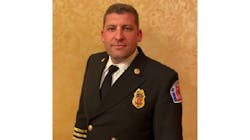Within any fire service organization, motivating personnel is essential for management to be successful. Performance, motivation and empowerment can drive improvement in the quality of work and in the productivity among employees.
Feeling motivated in the workplace can help people solve problems, create personal aspirations, and build expectations that align with organizational objectives. For employees to work productively toward the collective organizational goals, leaders must learn and understand the effective ways and methods to motivate, encourage and support.
Although this assertion holds great importance within a business, it also applies to the fire service community. In all emergencies, responders have the essential duty to provide urgent assistance and, in some situations, even provide a chain of survival, until delivered to definitive medical care. Therefore, the level of care, urgency and willingness of a first responder is affected by leaders' ability to motivate, support and encourage their crews. For the fire service, the capability to motivate has precipitating effects on the greater community.
To further explore this dynamic, let’s look at what leaders and managers can do to motivate their teams. Let’s discuss what traditional means and methods of motivation there are for this target group. Then, we will navigate the challenges and opportunities that exist in motivating this community. Finally, let’s examine the effect that COVID-19 has had on the service community.
Dissecting motivation
Motivation in the fire service won’t be successful with the “carrot and the stick” approach. That can work very well to modify the behavior of employees but not their motivation. Leadership is all about guiding teams away from actions that are punishable and toward behaviors and actions that are desired.
On a general scale, there is no nationwide or internationally agreed standard of training for the fire service community. However, each organization typically is equipped with some form of basic training, which often includes an extended skill set, such as fire behavior theory, basic EMT training, and related fireground operations.
However, after leaving the training environment, the reality of a firefighter’s role entails being first on scene and entering an emotionally distressing environment, sometimes alone. As an almost unspoken rule, firefighters must maintain composure, take control of the situation and take action that initiates tactics for survival. Very few carrots and no sticks are useful in navigating these situations.
Because the fire service community is made up of people of various generations and backgrounds and is as diverse as the communities that it serves, there is a necessity to address the motivators of these individuals for their sustained and ongoing commitment to the profession.
“Motivation of Emergency Medical Services Volunteers: A Study of Good Samaritans, which was conducted by Michael Khalemsky and his collaborators and published in Israel Journal of Health Policy Research, identified that the motivational functions that are served by firefighters can be understood based on six categories of psychological functions: values, understanding, enhancement, career, social and protective.
More specifically, according to “Why Do People Volunteer for Community First Responder Groups” by Alix Vernon-Evans and Stephen Timmons, these functions underscore the reasons for first responders: based on important values and beliefs (i.e., altruism and humanitarianism); for increased knowledge and the practice of unused skills; for psychological growth and development; to receive career-related experience; to aid in social acceptance, develop social groups and strengthen social relationships; and to reduce negative feelings and cope with inner anxieties.
Numerous studies have noted that altruism is a primary motivator. Data from a particular study found that individuals find giving back to the community, a desire to help and “community spiritedness” as prominent altruistic motivations. Other personal motivators include the desire to save lives, to contribute to healthcare services and to increase field experience for future healthcare-related careers.
From an organizational perspective, research provides insights that aim to encourage, engage and maintain the passion of being a firefighter, based on the psychological dimensions that drive their motivations. Traditionally, this entails the organization of cohesive groups of fire officers who provide dedicated leadership to sustain organizational engagement.
Recognition systems and awards apply, too, as does the availability of adequate support mechanisms to mitigate the adverse reactions and hardships of the firefighting profession. Additionally, according to Eithne Heffernan and her collaborators, who wrote, “Factors that Motivate Individuals to Volunteer to Be Dispatched as First Responders in the Event of a Medical Emergency: A Systematic Review Protocol,” firefighters are more likely to feel valued and to retain engagement when there are opportunities to contribute to policy development and decision-making, and when they receive formal feedback.
That said, there are inherent challenges to the process of motivating the first responder community: group dynamics and conflict (including bullying, exclusion and factionalism); conflicting opinions regarding the scope of practice; lack of support and friction with a health service interface; time pressures; and lack of recognition (from the public, medical professionals and patients). The same can be said for lack of progress or promotional opportunities in leadership roles, balancing the profession with personal and work life, and unmet training preferences.
It should be mentioned that, at times, the stress and emotional turmoil of the firefighter role can have a significant effect on an individual’s own life and mental stability. This can be burdensome, because firefighters typically must be “on call” for long periods of time, spend extended time away from family, respond to late-night emergencies, be thrust into high-pressure situations, and witness traumatic events.
The flip side
When it comes to opportunities to motivate, encourage, support and foster a cohesive environment for the fire service community, understanding these challenges allows leaders to gauge the satisfaction and well-being of their teams. By these means, there are opportunities to enhance recruitment and training, strengthen relationships with firefighters and stakeholders, expand the ways in which they are recognized and acknowledged, increase leadership opportunities, and implement a system for feedback.
Improvements in recruitment and training can be implemented through psychological examinations, scenario-based training exercises, and initiatives to develop practical and interpersonal skills. An emphasis on the vital relationship between ambulance staff and firefighters also is necessary to solidify mutual trust and effectively alleviate the patient’s situation, says Viet-Hai Phung and his collaborators in “Perceptions and Experiences of Community First Responders on Their Role and Relationships: Qualitative Interview Study,” which was published in Scandinavian Journal of Trauma, Resuscitation and Emergency Medicine.
Recognition and acknowledgement are a particular concern for many career professional firefighters. Creating an effective rewards program, in which awards can be earned in a timely and achievable manner, has been one of the most pressing opportunities of which leaders can take advantage. For those who have spent a long time within an organization, there is an opportunity to introduce policies and programs that enable those firefighters to embrace leadership roles and to further develop their leadership skills.
Strategic surveys, monthly meetings and online programs to gauge feedback address challenges and issues before they spiral out of control.
COVID-19
The low hanging fruit these days among demotivational factors in the U.S. fire service community is the adverse effect of COVID-19 on the workforce. The pandemic has forced first responders to risk exposure and to put their personal health and livelihood on the line. The stress and concern in regard to the pandemic has had an immense effect on communication systems, response coordination, and morale and mental health, which has led to personnel shortages and a decline in firefighter initial application rates.
Rather than just focusing on the emergent situation to which firefighters respond, we also have been constantly worried about their risk of exposure and, further, the detrimental effects that exposure could precipitate to their family at home and to their patients.
From another perspective, many spouses and significant others lost their daytime jobs and, therefore, face financial distress. Because of this, many firefighters might not have the means nor ability to give up more of their time to work overtime or to pick up shifts or to financially afford to be “on-call.”
These added stressors have had a striking effect on motivation and directly have affected psychological mindset, values of altruism, and the need and desire to continue to serve.
About the Author

Kristopher Blume
Kristopher T. Blume is the fire chief of the Meridian, ID, Fire Department and has more than two decades of fire service experience. He is an author, lecturer and independent consultant. Blume is a graduate of the Executive Fire Officer (EFO) program and is an instructor at the National Fire Academy. As a student of the fire service, he is focused on values-driven, mission-focused leadership for the profession. He is the author of "Carry the Fire: The Crucible of Leadership in the Fire Service".
